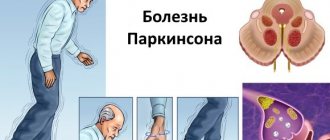Parkinson's disease mainly affects older people. The disease develops due to a lack of the neurotransmitter dopamine. It occurs in 120–180 people per 100 thousand population. The disease progresses steadily and leads to disability. Neurologists at the Yusupov Hospital use modern methods of treating Parkinson's disease, which can reduce the severity of symptoms and improve the quality of life of patients.
Memory tests
The simplest method for identifying memory impairment is the “5 words” test. The patient is given a sheet of paper on which 5 simple words from everyday vocabulary are written. After reading, the test taker must reproduce them. Then the patient is distracted by a conversation for 3-4 minutes and again asked to repeat the previously read words. If it is impossible to reproduce them immediately after reading, they speak of severe memory impairment, in other cases - of mild or moderate degree.
Another way to assess memory and memorization ability is a questionnaire test. The method is less informative because the testing does not exclude a subjective factor (a person may provide unreliable information). This test is suitable not only for the patient with Parkinson's disease, but also for his close relatives. Memory impairment is indicated when the answer is positive two or more times. The Parkinson's test consists of the following questions:
- Over the last month, have you forgotten to turn off the gas, iron or water?
- Have you lost things in the last month? If yes, how many times?
- Have you ever thought that a close relative looks completely different and you don’t recognize him?
- Do you have difficulty remembering a phone number or a date?
- Do you feel confused in a previously familiar area or area?
Another simple method for identifying the disease and concomitant mental disorders is the date recall test. The patient is asked to say when he or his immediate family was born. Long thinking, inability to answer a question, or ridiculous answers (for example, 03/45/1173) are an unfavorable sign.
Causes
Unfortunately, no reliable causes leading to Parkinson's disease have been identified. A certain role is given to environmental factors (especially contact with heavy metals), hereditary factors, the presence of repeated traumatic brain injuries and other undesirable effects, including taking certain medications. Some authors believe that the cause of Parkinson's disease is the presence of a prion infection.
Ultimately, the pathological cause of the disease is a disruption in the functioning of one of the areas of the brain - the substantia nigra. In this part of the brain, special neurotransmitters are produced - substances that allow communication between neurons, regulation of muscle tone, and much more. It is the disruption of the DOPA system that leads to all manifestations of the disease.
Tests to assess attention and thinking
A quick way to identify disorders of thinking and intelligence are mathematical problems. The patient is asked to solve examples with simple arithmetic operations (addition, subtraction, multiplication). The second stage of testing is counting backwards with subtracting the number 7. The test taker must subtract 7 from a given number (usually 100 or 1000), then name the resulting difference. The arithmetic operation is performed at least three times.
Important! The inability to perform basic arithmetic operations is a sign of severe impairment of intelligence and thinking.
Another cognitive (thinking) test for Parkinson's can be done at home. To do this, the patient is told two words that are related in meaning (for example, cat and dog). The test taker must explain what the relationship is between these words. Not only is the absence of a solution considered incorrect, but also answers based on secondary features (for example, “a cat and a dog have a tail” or “an orange and a banana have a peel”).
An accessible method for identifying attention disorders is a digital test. During this procedure, the patient is told 5 numbers from the top ten at a rate of 1 number per second. The test taker must repeat the numbers in forward and reverse order. You can also use graphic cards to assess attention. 10 images are laid out in front of the patient and given 60 seconds to memorize. The test taker is then asked to turn away and one of the cards is removed. The patient must determine which image is missing.
Symptoms
| Occurrence (how often a symptom occurs in a given disease) | |
| Trembling in the legs | 100% |
| Trembling in hands | 100% |
| Head shaking | 90% |
| Slowness of movement | 90% |
| Gait disturbance, difficult to specify (abasia) | 90% |
| Depletion of facial expressions | 90% |
| Stiffness, fatigue of the legs when walking and running | 90% |
| Depressed mood (bad mood) | 90% |
| Slowing down speech | 80% |
| Apathy (indifference, indifference) | 70% |
| Changing handwriting | 70% |
| Decreased thinking | 30% |
| Impaired coordination of movements | 20% |
| Gait disturbance (dysbasia, gait disturbance) | 20% |
Combined tests and questionnaires
In medicine, tests have been developed that allow one to identify several impaired mental functions at once. They consist of many tasks, each of which is responsible for memory, attention or thinking. The Mini-Cog test for Parkinson's disease has become widespread in clinical practice. At the beginning, the test taker is given 3 words that are not related to each other in meaning. The patient must then draw a clock face, place the numbers on it, and position the hands so that they show a specific time (for example, twenty minutes to four). After this, the test taker is asked to reproduce the words from the first task.
In clinical practice, another complex test is used - the Montreal Cognitive Function Assessment Questionnaire. It is used by psychiatrists to detect dementia due to Parkinson's disease. The test is considered difficult and requires 30-60 minutes to complete. It consists of several blocks and evaluates all higher brain functions of a person:
- abstract and spatial thinking;
- speed reaction;
- ability to remember and reproduce information;
- general level of intelligence;
- attention, its mobility and switchability;
- optical-spatial activity (the ability to determine the location, size, and distance of an object).
Important! The simplest and most informative method for identifying dementia in Parkinson's disease is the Mini-Cog test.
The test for Parkinson's disease consists of drawing a broken line, a three-dimensional object (cube, parallelepiped), or a clock dial with a given time. The questionnaire also contains arithmetic operations, reproduction of named words, naming numbers in reverse order, and simple logical tasks.
Varieties
Experts identify several classes of this anomaly, based on the age range for the onset of progression:
- Juvenile species.
- Early onset form.
- Late manifestation stage.
In addition, doctors also know other distinctive features of Parkinson's disease:
- Trembling.
- Trembling-rigid.
- Rigid trembling.
- Akinetic-rigid.
- Mixed.
The described variants of pathology are not complete, since there are individual cases that have various specific manifestations. That is why at the moment scientists have not come to the conclusion that only the above classes exist.
Tests to detect neurological disorders
Parkinson's disease is characterized not only by memory loss or cognitive-thinking dysfunction, but also by damage to the extrapyramidal system of the brain. It is responsible for movement, muscle tone and maintaining posture. Early signs of Parkinson's disease can be detected through simple neurological testing.
Neurological testing for Parkinson's disease
| Test | Norm | Parkinson's disease |
| Walking on level ground | Rhythmic steps at a speed of 80-100 per minute (for older people - at a pace that is comfortable for them), friendly hand movements while walking. When walking, the body is positioned vertically. | When walking, the center of gravity is shifted and the torso is tilted forward. The movement is carried out in small shuffling steps, the arms are chained to the body and immobilized. |
| Facial expression test with forehead frowning | 3-4 longitudinal folds on the forehead are clearly visible. | There are no facial wrinkles. |
| Graphics test | Individual handwriting, formed since childhood. | Distortion of handwriting due to trembling: slow and choppy writing of letters, small print (micrography). |
| Muscle tone test | Bending of the arm (the limb is bent not by the patient himself, but by another person) at the elbow joint occurs smoothly and without difficulty, then the limb acquires a physiological and comfortable position. | Bending the patient's arm requires effort and occurs intermittently, while the limb remains in a given position. |
Neurological disorders in parkinsonism appear earlier than cognitive-mental ones. Often the first symptom of the disease is tremor - shaking of the hands or nodding (like “yes-yes” or “no-no”) movements of the head. Tremors in Parkinson's can be distinguished from other neurological diseases in a simple way. Asking the patient to perform an action (for example, handing a glass or leafing through a book) will reduce the trembling. Weakening of tremor during movement is characteristic only of Parkinson's disease.
Parkinson's disease: what is it?
Parkinson's disease is a degenerative disease that affects the brain. Parkinson's causes the death of brain cells that primarily contain dopamine. These cells are located in the deep parts of the brain, namely in the basal ganglia. The death of these brain cells directly affects the functioning of muscles, the musculoskeletal system, walking, and the ability to control the limbs. Hence the typical picture of the manifestation of Parkinson's disease - changes in gait, tremor, specific stiffness of movements.
Diagnostic measures
To conduct certain studies, doctors use three techniques. Let's look at them in more detail:
- Detection of parkinsonism syndrome and its additional consequences, ranging from neurological and psychopathological abnormalities to similar symptoms.
- Exclusion from the list of other probable diseases that may have a provocative effect.
- Search for complaints that can confirm the conclusion - for this, specialists find out the presence of the following symptoms in the patient: unilateral reactions during the development of pathology, the presence of tremor, asymmetry, long-term illness for more than ten years, etc.
To conduct tests, doctors use: rheoencephalographic analysis, EEG, computed tomography and MRI scanning of the body.
Is it possible to diagnose the disease at an early stage?
Early diagnosis is always a difficult process. At stages when the disease does not yet manifest itself properly, it is difficult to accurately differentiate it. Parkinson's syndrome is no exception.
This pathology has 8 stages of development:
- Stage 0 – no symptoms;
- Stage 1 – signs appear on one limb;
- Stage 1.5 – spread of manifestations from the affected limb to the torso;
- Stage 2 – the beginning of bilateral manifestations;
- Stage 2.5 – bilateral manifestations with instability;
- Stage 3 – bilateral symptoms. The patient is unstable, cannot overcome the force of inertia;
- Stage 4 – limited movement. The patient needs outside help;
- Stage 5 – the patient is confined to a wheelchair.
The human factor also plays an important role. Naturally, when no manifestations are observed (as in the zero stage), the person does not know that he is sick. According to statistics, people often come to the doctor with stage 1.5 or later. This makes it very difficult for doctors to make an early diagnosis.











